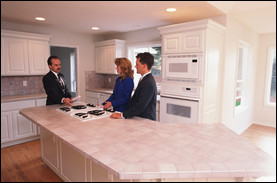 The key to a successful tile counter is choosing a tile and grout that can live up to the spills, chopping, and heat of the kitchen. |
Tile is known for its heat resistance and beauty. It comes in several forms, sizes, and colors and can be manufactured or handcrafted for an artisanal look. When selecting tile for the kitchen, it is best to evaluate the tile’s qualities and pay special attention to sealing the grout to get a surface that will live up to the demands of a busy kitchen.
Tile Types
Ceramic, porcelain, and stone are the most commonly used types of tile for kitchen counters, but concrete tiles are fast becoming an accepted surface. Ceramic tile is a pressed clay that is fired and glazed. It includes mosaics and ranges from half-inch to three-inch pieces. It’s the softest of the lot and, if chipped, will expose its base color of brown or white.
Porcelain tiles are extremely dense because they are made of clays characterized by a low water absorption rate. They are fired at extremely high temperatures and are known for durability that can even rival granite’s. Porcelain tiles are typically 11 to 14 inches square and can be glazed or through-body. Glazed porcelain is similar to ceramic tile and has a base with a color glaze over the top. Chipping a glazed tile leaves the base color exposed. Through-body porcelain, as the name implies, has color throughout the product, allowing it to be cut, mitered, bullnosed, or otherwise shaped to go around sinks.
Stone tiles, typically 12 inches square, are usually granite for use in the kitchen. Marble gets occasional use, but is a softer stone that is more prone to staining and damage.
Concrete tiles offer a newer, highly durable surface that can be colored to match décor. Concrete tiles are typically 24 by 25½ inches and come in standard countertop depths. Concrete tiles come as basic tiles or with a separate back and side splash for about half the price of a concrete countertop.
Tile Maintenance and Repair
Discolored grout is the biggest drawback to living with tile. Grout is porous and tends to absorb water when the seal breaks down. This can lead to discoloration, mold, or water penetrating the grout and getting behind the tile. Sealing and regular cleaning help keep grout joints stain-free. Mike Lee of Brighton Restoration, Salt Lake City, Utah, recommends a light bleach and water concentrate for white grout and a light vinegar solution for colored grout.
Some natural stone tiles have issues with staining from coffee, hot oils, or lemon juice. They, too, require regular sealing. Glazed tiles, like porcelain, have their own finish and don’t require surface upkeep.
Tile can be scratched or chipped. Edges are especially vulnerable to dings from pots, pans, or barstools. Ceramic tiles tend to chip more easily than others. A tile surface can be repaired by replacing damaged tiles with new ones. This typically involves chiseling out the damaged tile and replacing it with a similar tile. For that reason, it’s good to squirrel away a few tiles for possible future repair. It’s also important to remember that all tiles for a project should come from the same batch, identified by batch number, to ensure that the color and finish are the same.
Tile Counter Installation and Costs
Cost for tile counters vary depending on the tile chosen and the quality of the installation. Figure $35 to $40 a square foot for installation and tile. Creating fancy inlays and cutting tiles to fit intricate spaces will add to the cost.
There are two schools of thought about installing tile, says Lee. Old school suggests using a vapor barrier on a plywood base, wire mesh, a cement base, and a thinset of cement and sand with a latex additive to allow time for placement. The installer would then finish with a colored cement-based grout.
Cement backer board makes a second method of installation possible that lets handyman tile setters or homeowners complete a professional quality installation job. When using cement backer board, a plywood base is screwed to the counter before the cement backer board is screwed and glued to it. The tiles are installed on this base with thinset and grout finish. This method is quicker and may offer a small cost savings.
Regardless of the method, a poor installation can result in tiles moving or popping up. Tiles with uneven or rounded edges may pose more maintenance issues because they often require a wider grout line.
New Use for Tile
Tile can be a difficult surface in a kitchen because of the grout and the uneven surface. “You can’t roll anything out on it,” says Burt. Very often homeowners will create a mix of surfaces to accommodate cooking, entertaining, and aesthetic needs.
Tile is often used for kitchen islands, but is especially popular as a backsplash because it can be personalized to highlight the décor or the personality of the homeowners. A custom look can be achieved with stock tiles arranged in an unusual pattern, mixes of tiles in shapes, sizes, and textures, or artisan-inspired tiles made from sandblasting, a fired printed image, or even handpainting.
Credit: Renovate Your World




























